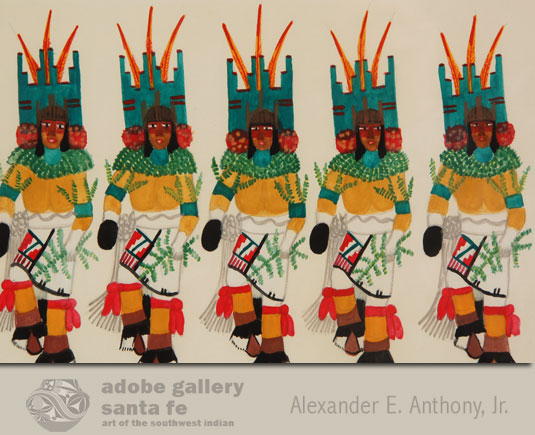San Ildefonso Pueblo Painting of Six Male Dance Scenes by José Encarnacion Peña [SOLD]
+ Add to my watchlist Forward to Friend
- Category: Paintings
- Origin: San Ildefonso Pueblo, Po-woh-ge-oweenge
- Medium: watercolor
- Size:
24-⅝” x 29-⅜” image;
27-¼” x 32” framed - Item # C4059.16 SOLD
This untitled painting is the largest and most elaborate Soqween painting that Adobe Gallery has ever handled. It contains six rows of seven dancers each, for a total of 42 dancers. Each is depicted, as is Soqween’s style, head on. Red, yellow, and green watercolors were the artist’s tools here, giving the image a bright and vibrant feel. Brown was used, too, in the dancer’s faces and moccasins. In what was likely a laborious process, impressive detail was paid to their kilts and evergreen boughs. Their feathered headpieces, too, are composed very skillfully. It feels as if the viewer has an aerial view of the proceedings but is just close enough to see the details of the dancers’ garb. It’s a very special piece from one of the most uniquely talented San Ildefonso Pueblo painters.
A San Ildefonso friend of the gallery provided information about the ceremonies depicted here. Each of the six groups of dancers seen here is an individual dance. Each of these dances happens during the spring or fall and is performed exclusively by men. The group in the top left performs the Straight Dance, wearing headdresses adorned with eagle feathers. The group in the top right performs the Parrot Dance. The group in the middle left performs the Tablita Dance. The group in the middle right performs the Line Dance. The group in the lower left performs a dance which our friend referred to as "Rain Hitting Ground Bounce Up." In the lower right, we see one of Peña's favorite subjects—the Basket Dance. The Baskets Dancers' headresses are made of turkey feathers.
The painting is framed beautifully. It is unsigned but is without question the work of José Encarnacion Peña.
José Encarnacion Peña was one of the students of Dorothy Dunn at The Studio of the Santa Fe Indian School in the early 1930s. He had started painting well before then, though—as early as the 1920s. He continued until his death in 1979. His Tewa name was Soqween, though it appeared on his painting in various spellings. Soqween translates to “Frost on the Mountain.” Those who remember him in his later years recall that he was usually referred to as “Enky.”
José Encarnacion Peña (1902-1979) Soqween - So Kwa A Weh (Frost on the Mountain) was painting at San Ildefonso Pueblo at the same time as Tonita Peña, Ricahard Martínez, Luís Gonzales, Abel Sánchez, and Romando Vigil. In his early years, he was not as prolific as his peers. It was during the last ten years of his life that he became productive. He is represented in the collections of the Laboratory of Anthropology, Santa Fe; Museum of New Mexico; Denver Art Museum; and many others.
Though similar in spirit, Soqween’s works are very different from those of his contemporaries. His works are simple, often using just two or three colors. His outlines, often done in light grey, are less important to his compositions than the thick blocks of bold colors with which they are filled. These blocks of color are the tools with which he composed his subjects: Pueblo dancers, in traditional regalia, often viewed head-on instead of in profile. Soqween’s style is a simple, charming, and unusual variation of the “flat” style that he and his peers were taught at the Santa Fe Indian School.
Condition: this San Ildefonso Pueblo Painting of Six Male Dance Scene by José Encarnacion Peña is in excellent original condition.
Provenance: from the large collection of a Santa Fe resident who is downsizing
Recommended Reading: American Indian Painting of the Southwest and Plains Areas by Dorothy Dunn (1903-1992)
Relative Links: José Encarnacion Peña, Dorothy Dunn, San Ildefonso Pueblo, Tonita Peña, Ricahard Martínez, Luís Gonzales, Abel Sánchez, Romando Vigil, Native American Painting

- Category: Paintings
- Origin: San Ildefonso Pueblo, Po-woh-ge-oweenge
- Medium: watercolor
- Size:
24-⅝” x 29-⅜” image;
27-¼” x 32” framed - Item # C4059.16 SOLD



